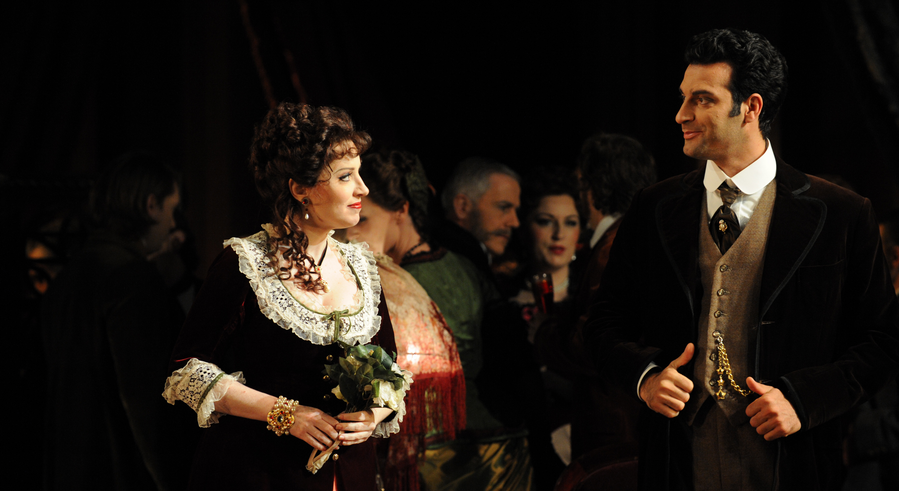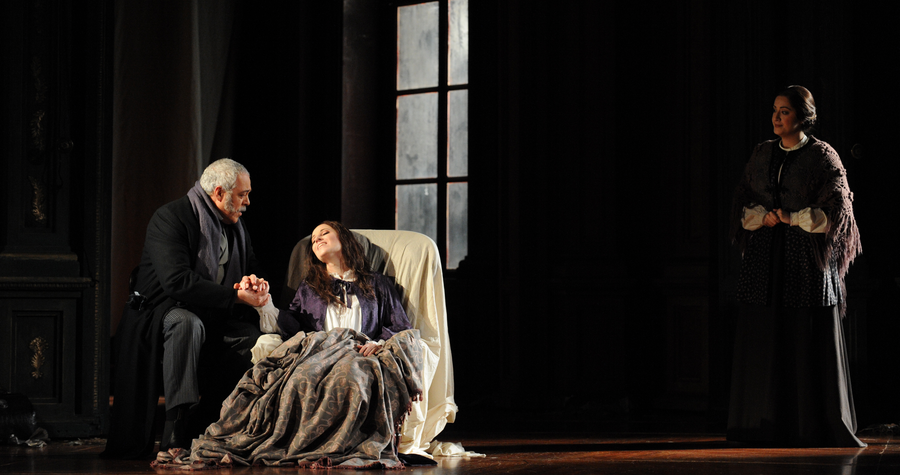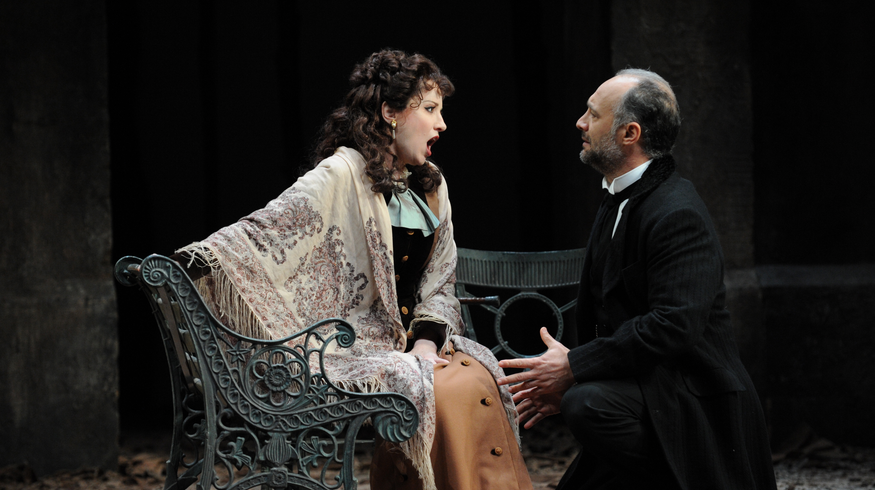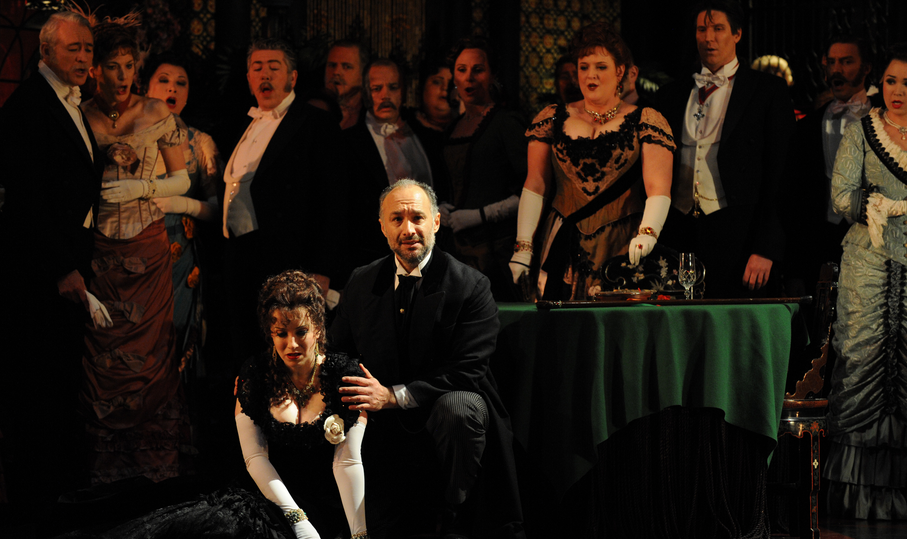Demi-monde brought fully to life in beautifully cast and conducted revival.
Joan Sutherland Theatre, Sydney Opera House
July 3, 2015
It’s the winter season, a time for hunkering down and not wishing to expose too much to the elements. And it’s no different in the opera world. Following their excellently sung revival of Graeme Murphy’s 25-year-old Turandot, OA are at it again with Elijah Moshinsky’s hyper-naturalistic staging of Verdi’s La Traviata – a production that has just earned opera’s ‘key of the door’ as it passes its 21-year milestone. In the case of revivals of such venerable fare it’s important to review from two different angles: what can the opera newbie expect, and why might a Traviata-ed out operaphile fork out three hundred bucks to sit through another night of Verdi’s most programmed?
 Lorina Gore (Violetta Valéry) and Rame Lahaj (Alfredo Germont)
Lorina Gore (Violetta Valéry) and Rame Lahaj (Alfredo Germont)
Nothing typifies romantic opera quite like La Traviata, and few productions could be described as being quite so faithful to Verdi (and equally importantly to Dumas, whose La Dame Aux Camélias Elijah Moshinsky has clearly studied and reverenced). In short, while it may come across as the epitome of traditionalism, it is directed with great insight, an extraordinary sense of period manners, and visually it is as exquisite as the finest Merchant Ivory film.
Michael Yeargan’s sumptuous sets are heavy with gilt and brocades, the atmosphere redolent of cigar smoke and gaslight. Violetta’s drawing room is warm, yet oppressive in that mid-Victorian way, and when full of party guests it is as cramped as one would imagine a salon of the demi-monde to have likely been. Rugs have been thrown down higgledy-piggledy and it’s standing room only to catch a glimpse of the hostess doing her party piece. Stripped of every trapping for the final scene, the former ‘grande courtesan’ is a tiny, wasted figure, the absence of every frill and furbelow leaving her pitifully exposed. Peter J Hall’s meticulously researched costumes and Nigel Levings’ detailed, hyper-naturalistic lighting each add to the overall sense of actually being there.
 Gennadi Dubinsky (Doctor Grenvil), Lorina Gore (Violetta Valéry) and Natalie Aroyan (Annina)
Gennadi Dubinsky (Doctor Grenvil), Lorina Gore (Violetta Valéry) and Natalie Aroyan (Annina)
Moshinsky aims for a form of über-naturalism. The hours pass in real time, it’s easier to read in the garden where the light is better, autumn leaves fall slowly, one by one. His figures behave less like opera singers, more like real people, and especially real people of the time. When she’s unwell, Violetta falls – a lot. When party guests dress up to spoof gypsies it’s all a bit cod – naff even. Through a sensitivity to the world in which these people must have moved, Moshinsky’s incisive direction creates a cast of motivated, conflicted, three-dimensional figures who sway our emotions with a keen sense that all are essentially decent, it’s just the time and place that’s against them.
All of that should satisfy the newbie, but what’s in it for the seasoned operagoer? In the case of regular revivals that comes down to matters of cast and conductor and fortunately this production is blessed with a cornucopia of riches. In the title role, Lorina Gore is making her role debut for OA and a most auspicious one it is. A coloratura of note and experience, you might think she’d been cast to nail Ah, fors’è lui and Sempre libera but as it turns out she impresses the most in the lyric soprano territory of acts two and three. Not that the coloratura isn’t impressive. She’s flexible with a substantial power behind every note and a technique to match. Just occasionally there’s a moment of insecure intonation and the optional E Flat at the end of act one was a bit skin-of-the-teeth on opening night (nerves? I recall it being less effortful at an Opera in the Domain a couple of years back). The second act finds her particularly striking in her confrontation with José Carbó’s austere Père Germont – her initial anger impresses and Dite alla giovine is deeply felt. However, it’s her performance in the crucial final act – a broken doll, worn out all too soon – that makes her such a memorable Violetta. Addio, del passato is lovingly shaped, and thanks to a well-chosen tempo Gran Dio! morir sì giovane has an unusually convincing air of desperation.
 Lorina Gore (Violetta Valéry) and José Carbó (Giorgio Germont)
Lorina Gore (Violetta Valéry) and José Carbó (Giorgio Germont)
Her Alfredo is Kosovo-born tenor Rame Lahaj and a very fine voice it is too. Lyrical and easy, he has the elegance of a Bergonzi and can scale it down to a seductive whisper, as he does so touchingly in Parigi, o cara. His top notes are mostly excellent and well connected to his burnished middle register. De’ miei bollenti spiriti is perfectly judged, ardent and wide-eyed, only the final optional top note in the cabaletta was surprisingly sharp. With his smouldering good looks he and Gore are an excellent match and highly persuasive, though he might try harder to resist the temptation to indulge in the occasional stock gesture.
José Carbó reprises the role of Giorgio Germont, cementing his reputation as Australia’s leading Verdi lyric baritone. Singing with firm tone and sporting some fine top notes he delivers one of the finest renditions of the deceptively demanding Di Provenza il mar that I can recall. Dramatically too he captures the character’s essential gravitas while negotiating his complex psychological journey from self-centred bourgeois to remorseful father and friend.
 Lorina Gore (Violetta Valéry) and José Carbó (Giorgio Germont)
Lorina Gore (Violetta Valéry) and José Carbó (Giorgio Germont)
The supporting roles are well cast, from Gennadi Dubinsky’s stolid doctor to Natalie Aroyan’s defensive Annina. John Longmuir makes a memorable Gastone, Luke Gabbedy and Pelham Andrews do sterling service as Marquis and Baron respectively. Dominica Matthews sings a catty Flora with fine tone, but overplays her dramatic hand in a role that could use a touch more subtlety.
None of this would work quite so well were it not for a sure lead from the pit, and Renato Palumbo is much more than just a safe hand on the tiller. This is Verdi conducting of the highest order, from the ethereal strings of the beautifully shaped preludes to acts one and three, through his dynamic handling of the party scenes, to the sense of ebb and flow he brings to individual arias and duets. Time and again he judges a suspension just right to allow a singer to do what he or she does best. The Opera Australia chorus are similarly spot on, singing with their customary power and commitment and relishing the individuality of characterisation that Moshinsky’s production demands.
As a byword, exactly two weeks previously I was privileged to be at Covent Garden to see Richard Eyre’s equally staple, ultra-traditional production of the same opera. I was there to see young Aussies Samuel Sakker and Samuel Dale Johnson as Gastone and the Baron, both of who are on the ROH Jette Parker Young Artists Programme and both of who were excellent, both vocally and dramatically. Without going into too much detail, I’ll admit I found Moshinsky’s production more insightful, Palumbo’s conducting more sympathetic and each of Opera Australia’s three leads more involving. Lorina Gore may not be quite as ‘on the money’ vocally in the first act as rising star Sonya Yoncheva, but once that was out of the way she outshone her at almost every turn – and that isn’t meant to disparage either soprano, both of who are excellent.
This revival may look unremarkable on paper, but it offers a great deal and would make a perfect ‘in’ for anyone wanting to dip their toe into opera’s heady waters. And although premium tickets are indeed $300, you can get a decent stalls seat for $99. Well worth a go, I’d say.
La Traviata is at Sydney Opera House until July 22.












Comments
Log in to join the conversation.